本文由 ICD 授权mooool发表,欢迎转发,禁止以mooool编辑版本转载。
Thanks ICD for authorizing the publication of the project on mooool, Text description provided by ICD.
ICD:ICD/ITKE研究馆2014-15展示了一种新型建筑方法的建筑潜力,其灵感来自于水蜘蛛的水下巢穴结构,利用新型的机器人制造工艺,从内部用碳纤维加固气动模板,使其逐渐变硬,由此产生的轻质纤维复合外壳形成了一个具有独特建筑品质同时也具有高材料效率的展馆结构。
ICD:The ICD/ITKE Research Pavilion 2014-15 demonstrates the architectural potential of a novel building method inspired by the underwater nest construction of the water spider. Through a novel robotic fabrication process an initially flexible pneumatic formwork is gradually stiffened by reinforcing it with carbon fibers from the inside. The resulting lightweight fiber composite shell forms a pavilion with unique architectural qualities, while at the same time being a highly material-efficient structure.

▼灵感来源 Source of inspiration
▼视频 Video
斯图加特大学的计算设计研究所(ICD)和建筑结构与结构设计研究所(ITKE)新建了2014-2015年ICD/ITKE研究展馆后,继续展开了他们的展馆系列研究。这些建筑原型探索了新的计算设计、模拟和制造过程在建筑中的应用潜力。该展馆是在两个研究所的研究领域和他们在跨学科和国际ITECH MSc项目背景下的合作教学的交叉点开发的。这个典型的项目是由建筑、工程和自然科学的研究人员和学生经过一年半的研究开发而成的。
The Institute for Computational Design (ICD) and the Institute of Building Structures and Structural Design (ITKE) continue their series of research pavilions with the new ICD/ITKE Research Pavilion 2014-15 at the University of Stuttgart. These building prototypes explore application potentials of novel computational design, simulation and fabrication processes in architecture. The pavilion was developed at the intersection of the two institute’s research fields and their collaborative teaching in the context of the interdisciplinary and international ITECH MSc program. This prototypical project is the result of one and a half years of development by researchers and students of architecture, engineering and natural sciences.
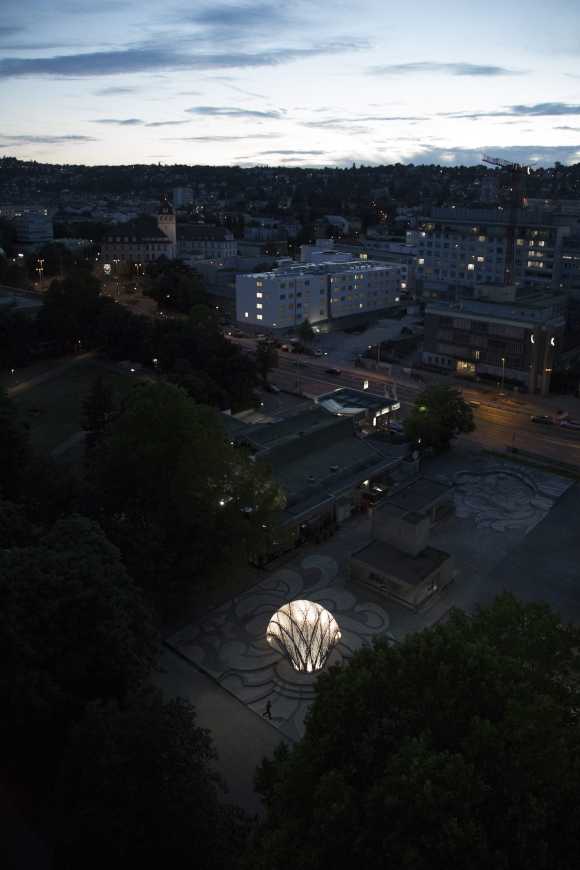

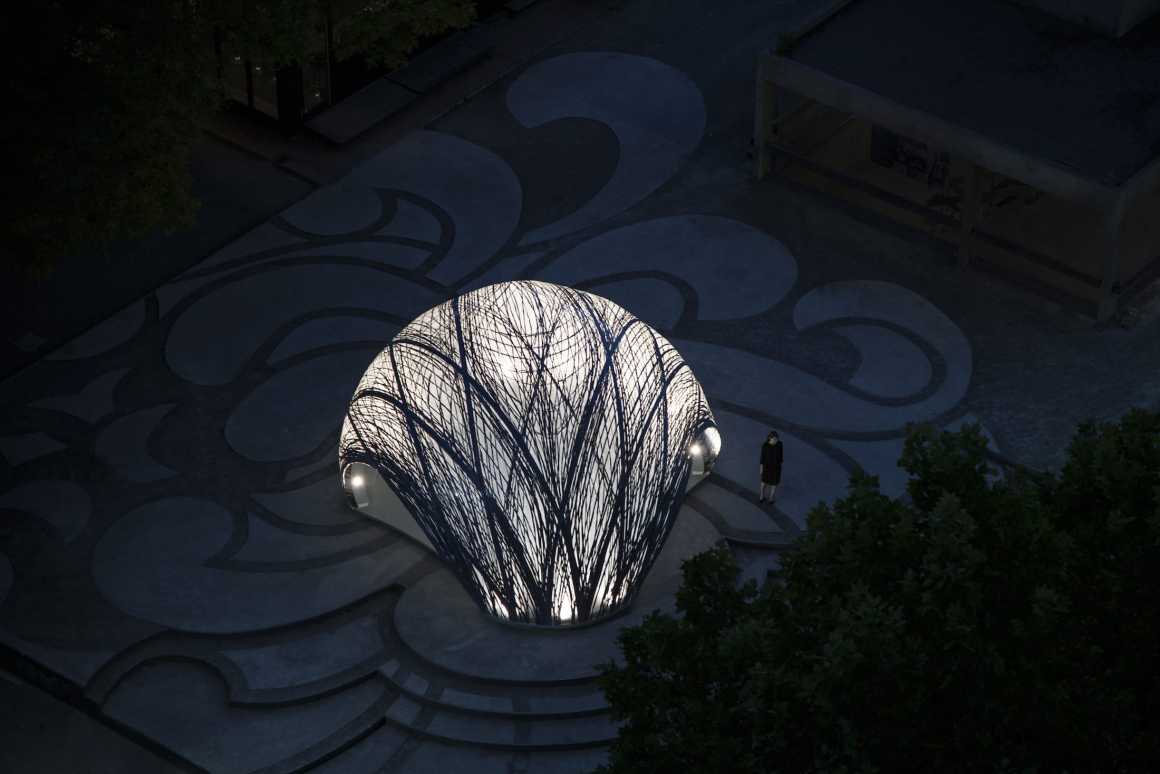

该展馆的设计理念基于对纤维增强结构的生物构建过程的研究。这些过程与体系结构中的应用程序相关,因为它们不需要复杂的模板,并且能够适应各个结构的不同需求。生物构建过程以高度材料有效和功能集成的方式形成定制的纤维增强结构。在这方面,潜水钟形水蜘蛛(Agyroneda Aquatica)的织网过程特别有趣的,通过研究水蜘蛛的腹板构造过程,分析、抽象水蜘蛛的基本行为模式和设计规则,我们将其转化为了建筑技术工艺制造过程。
The design concept is based on the study of biological construction processes for fiber-reinforced structures. These processes are relevant for applications in architecture, as they do not require complex formwork and are capable of adapting to the varying demands of the individual constructions. The biological processes form customized fiber-reinforced structures in a highly material-effective and functionally integrated way. In this respect the web building process of the diving bell water spider, (Agyroneda Aquatica) proved to be of particular interest. Thus the web construction process of water spiders was examined and the underlying behavioral patterns and design rules were analyzed, abstracted and transferred into a technological fabrication process.

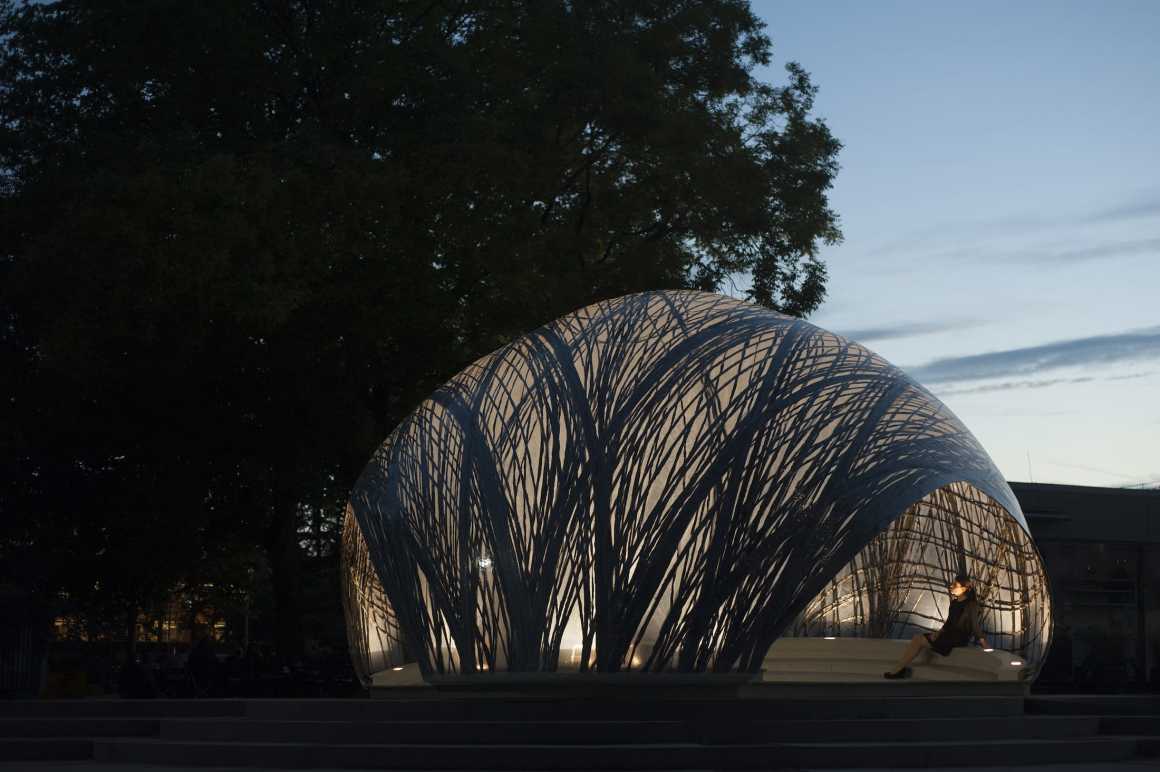
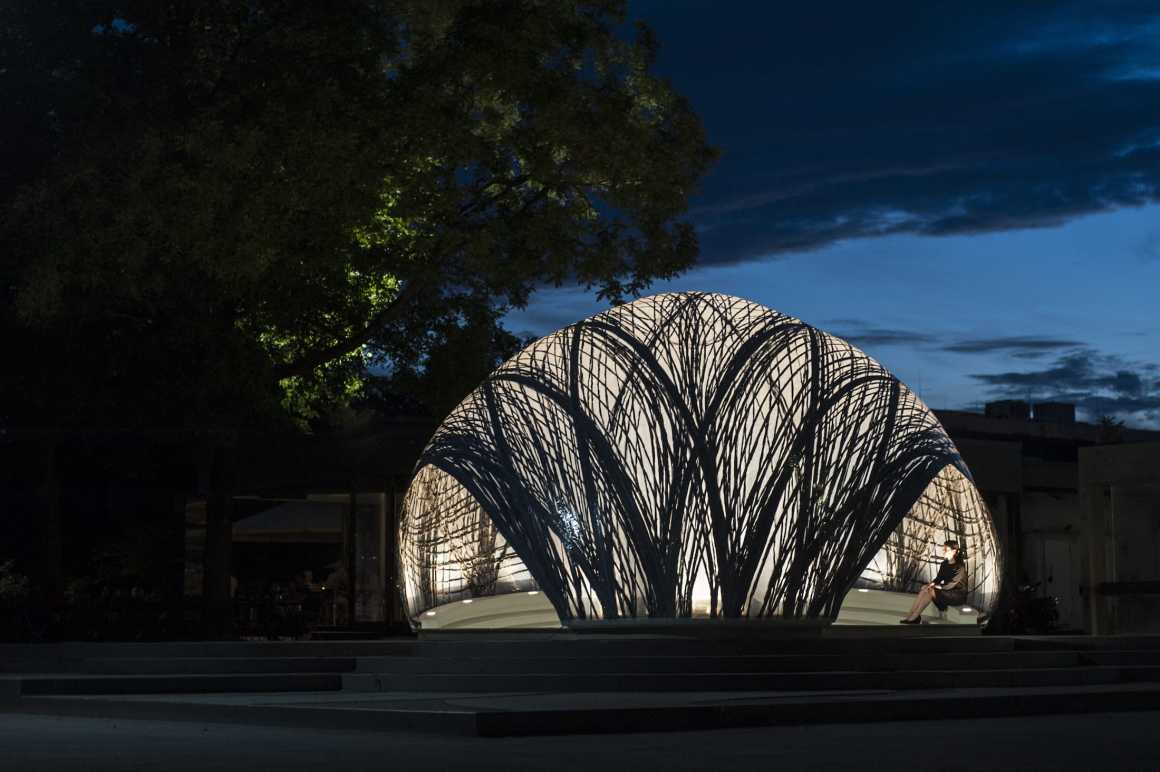
水蜘蛛一生大部分时间都生活在水下,为了生存,它建造了一个加固的气泡。水蜘蛛首先会建立一个水平的薄片网,在下面放置气泡,然后,通过从内部铺设分层排列的纤维来依次增强气泡,最后形成可以承受机械压力,如改变水流的稳定结构,为蜘蛛提供一个安全稳定的栖息地。这个自然的生产过程展示了如何利用自适应制造策略来创建高效的纤维增强结构。
The water spider spends most of its life under water, for which it constructs a reinforced air bubble to survive. First, the spider builds a horizontal sheet web, under which the air bubble is placed. In a further step the air bubble is sequentially reinforced by laying a hierarchical arrangement of fibers from within. The result is a stable construct that can withstand mechanical stresses, such as changing water currents, to provide a safe and stable habitat for the spider. This natural production process shows how adaptive fabrication strategies can be utilized to create efficient fiber-reinforced structures.
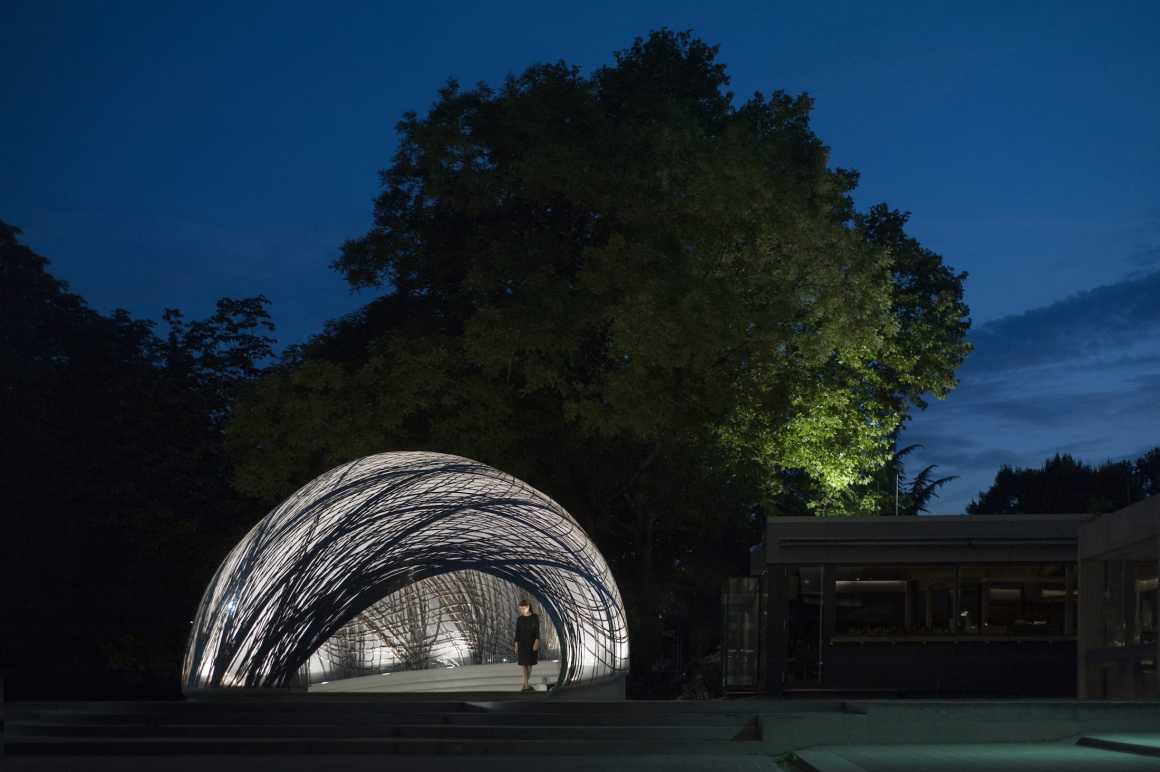

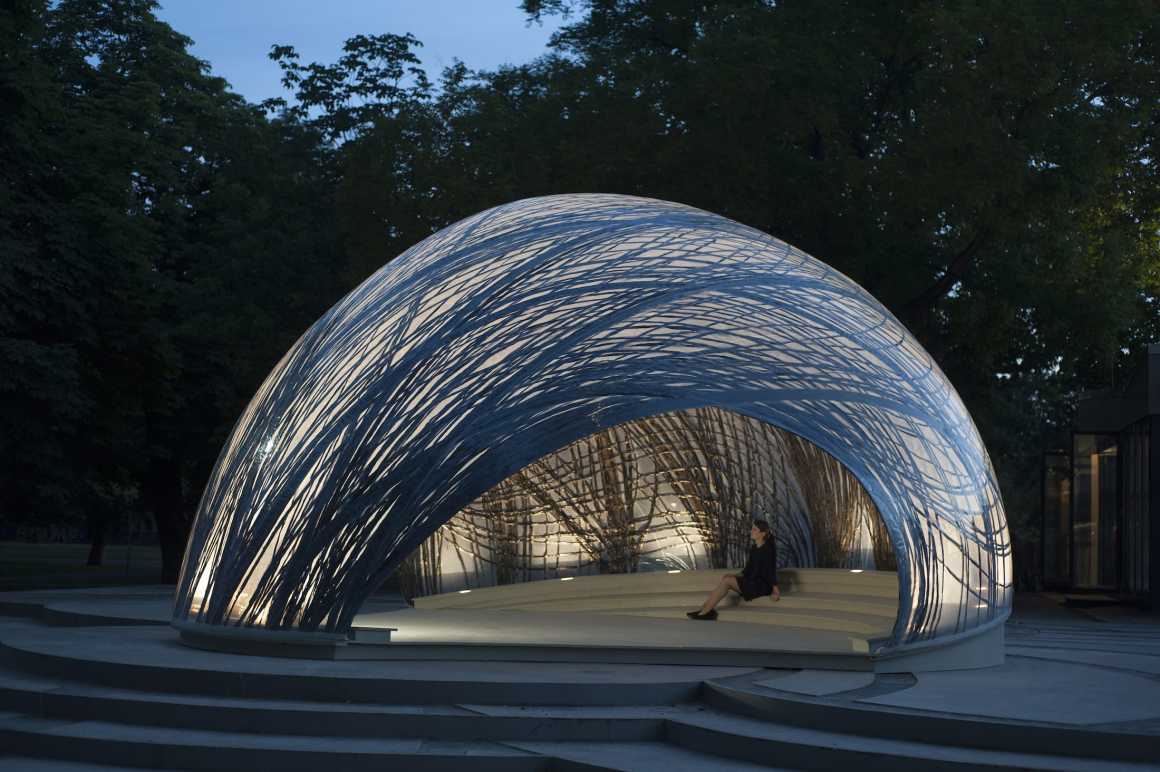

为了将这种生物形成序列转化为建筑施工应用,我们开发了一种建筑工艺,即将工业机器人放置在由ETFE制成的空气支撑薄膜包膜内,这个膨胀的软壳最初由气压支撑而起的,然后,通过用碳纤维机械加强内部,使它逐渐变硬成为一个自支撑的硬壳结构。碳纤维仅有选择地使用在结构需要加固的地方,气动模板同时作为功能集成的建筑表皮,这就是一个资源高效的建设过程。
For the transfer of this biological formation sequence into a building construction application, a process was developed in which an industrial robot is placed within an air supported membrane envelope made of ETFE. This inflated soft shell is initially supported by air pressure, though, by robotically reinforcing the inside with carbon fiber, it is gradually stiffened into a self-supporting monocoque structure. The carbon fibers are only selectively applied where they are required for structural reinforcement, and the pneumatic formwork is simultaneously used as a functionally integrated building skin. This results in a resource efficient construction process.
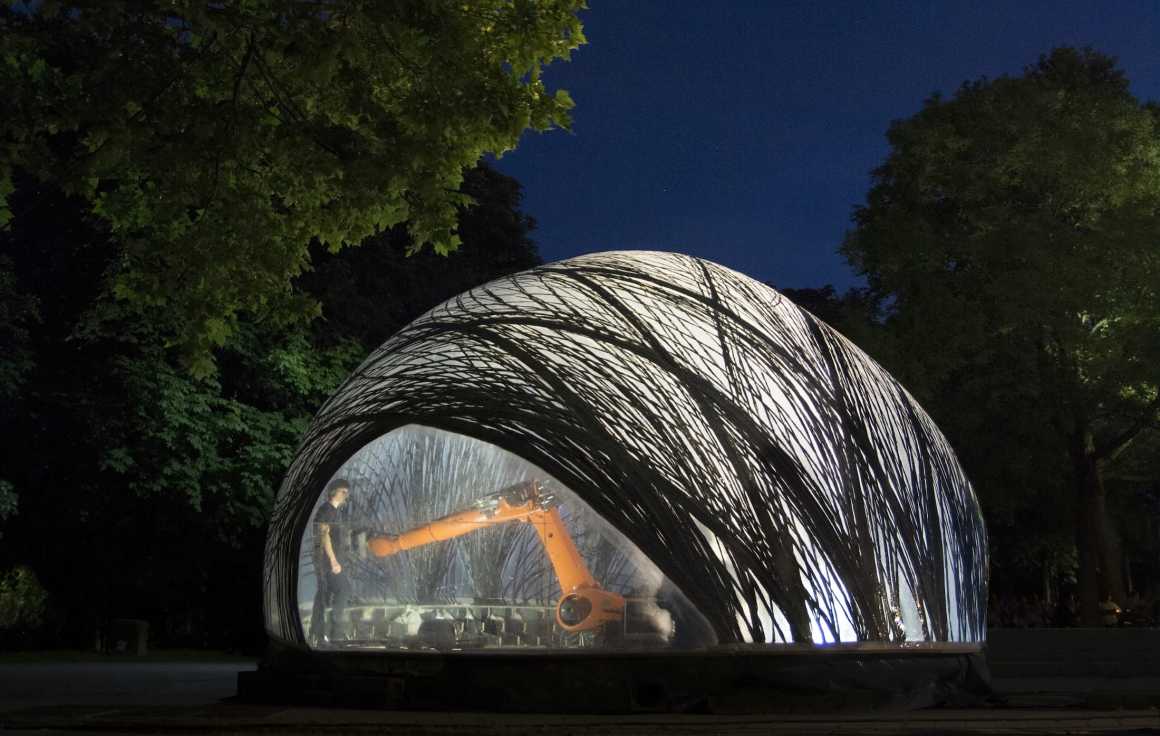

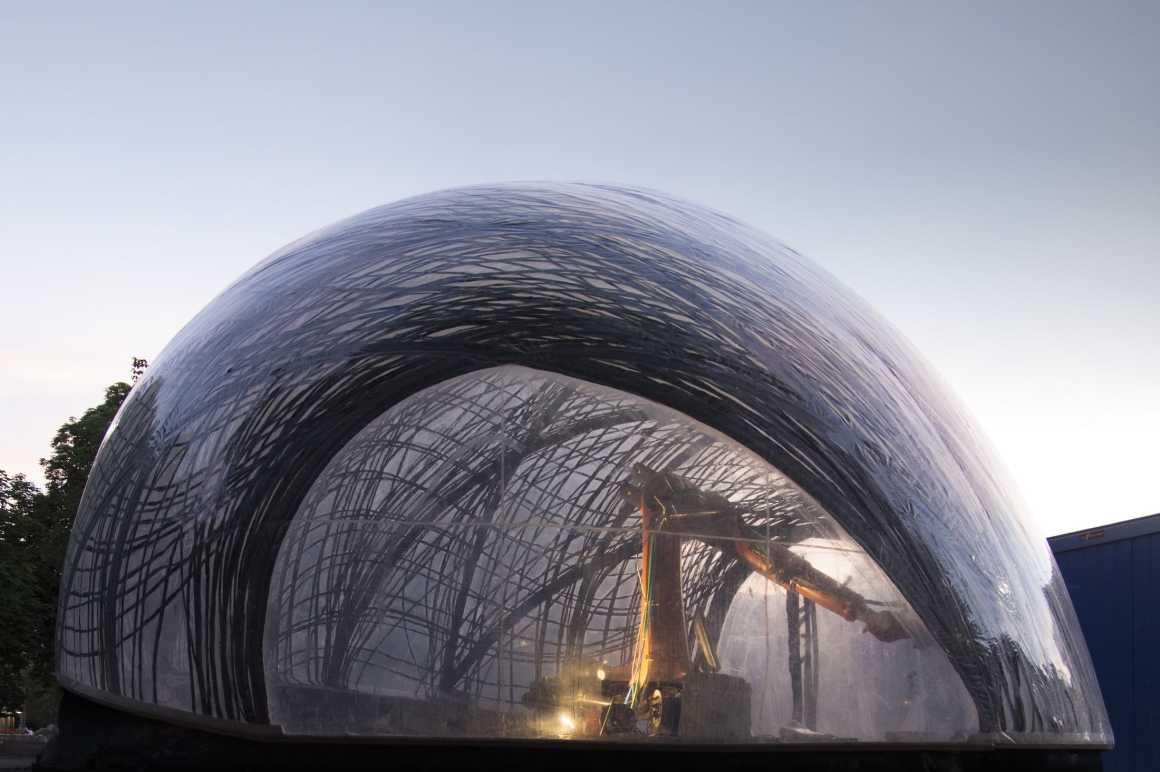
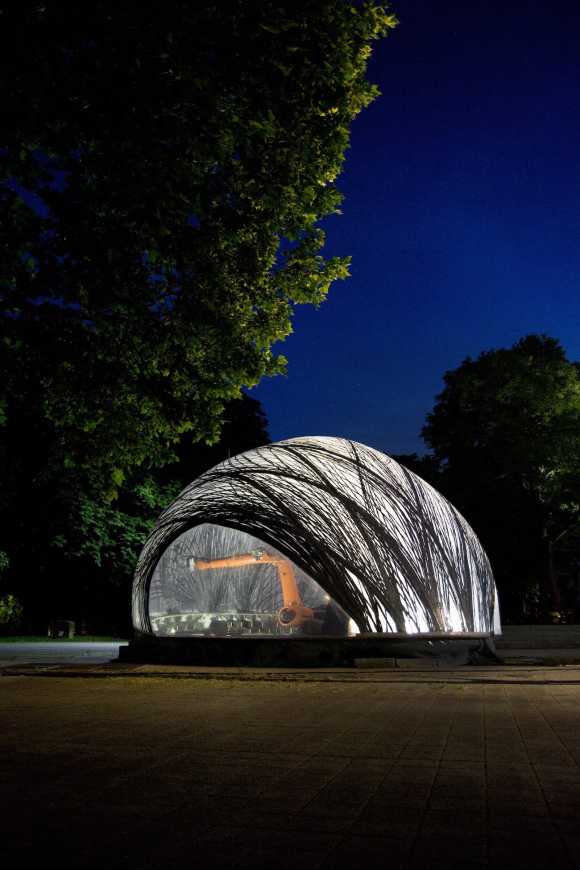
▼施工细节 Construction detail
在设计和施工过程的初始阶段,采用计算形式生成壳体几何形状和主要纤维束位置,该方法结合了制造约束和结构仿真。为了确定和调整光纤布局,我们提出了一种基于计算代理的设计方法,与蜘蛛类似,利用数字代理导航表面外壳几何形状,生成一个用于纤维放置的机器人路径,其代理行为源自各种相关的设计参数。这种计算设计过程使设计师能够导航,并同时将这些设计参数集成到各种性能化纤维取向和密度中。
At the beginning of the design and construction process, the shell geometry and main fiber bundle locations are generated by a computational form finding method, which integrates fabrication constraints and structural simulation. In order to determine and adjust the fiber layouts a computational agent-based design method has been developed. Similar to the spider, a digital agent navigates the surface shell geometry generating a proposed robot path for the fiber placement. The agent behavior is derived from a variety of interrelated design parameters. This computational design process enables the designer to navigate and simultaneously integrate these design parameters into various performative fiber orientations and densities.
▼计算机参数设计 Computer parameter design © ICD-ITKE
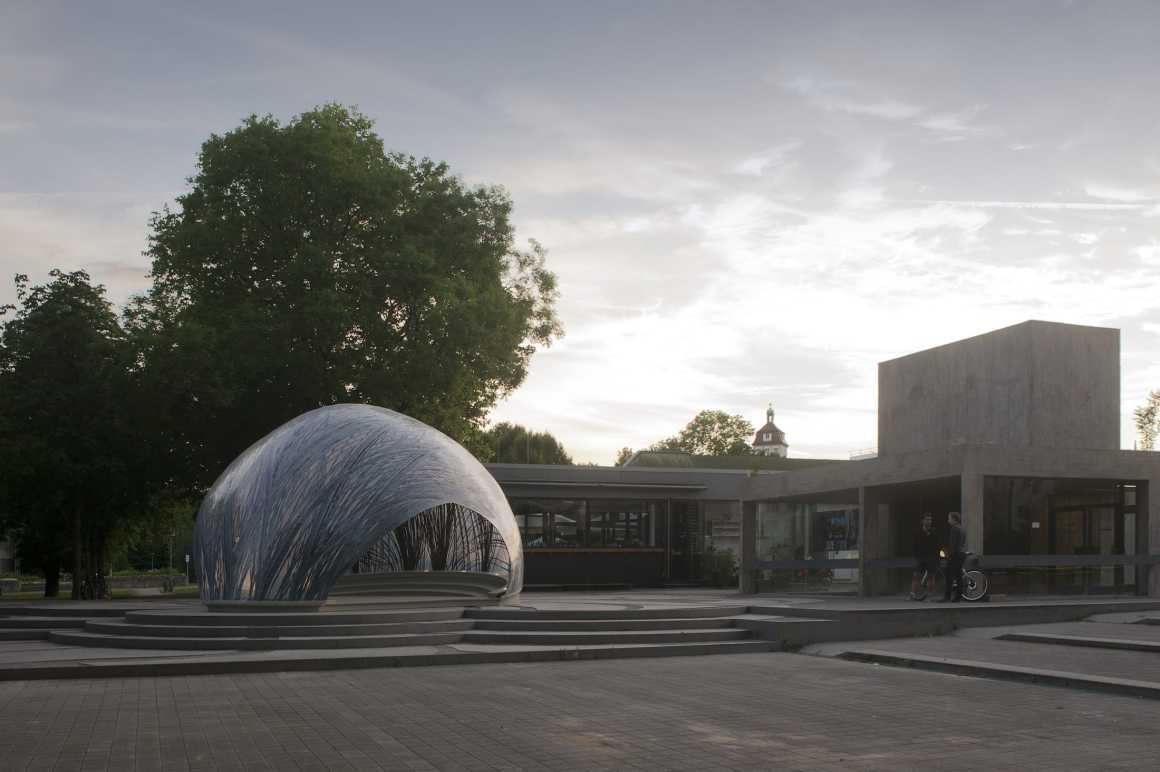
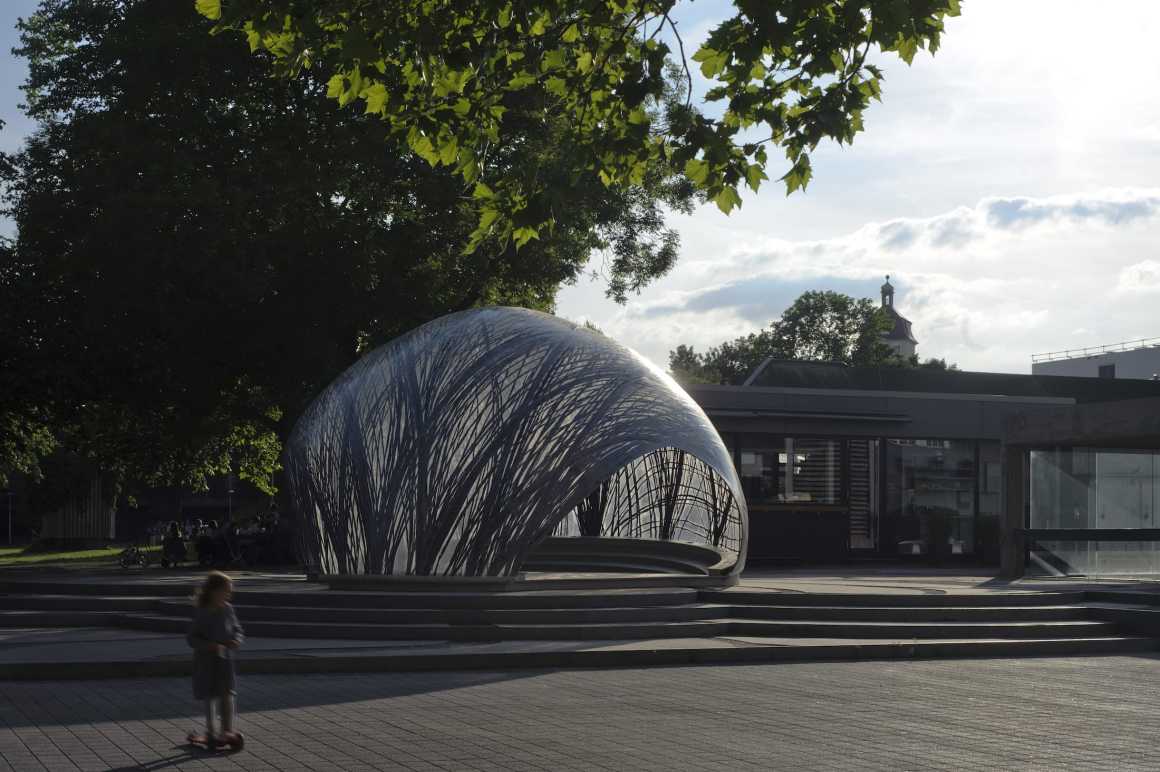
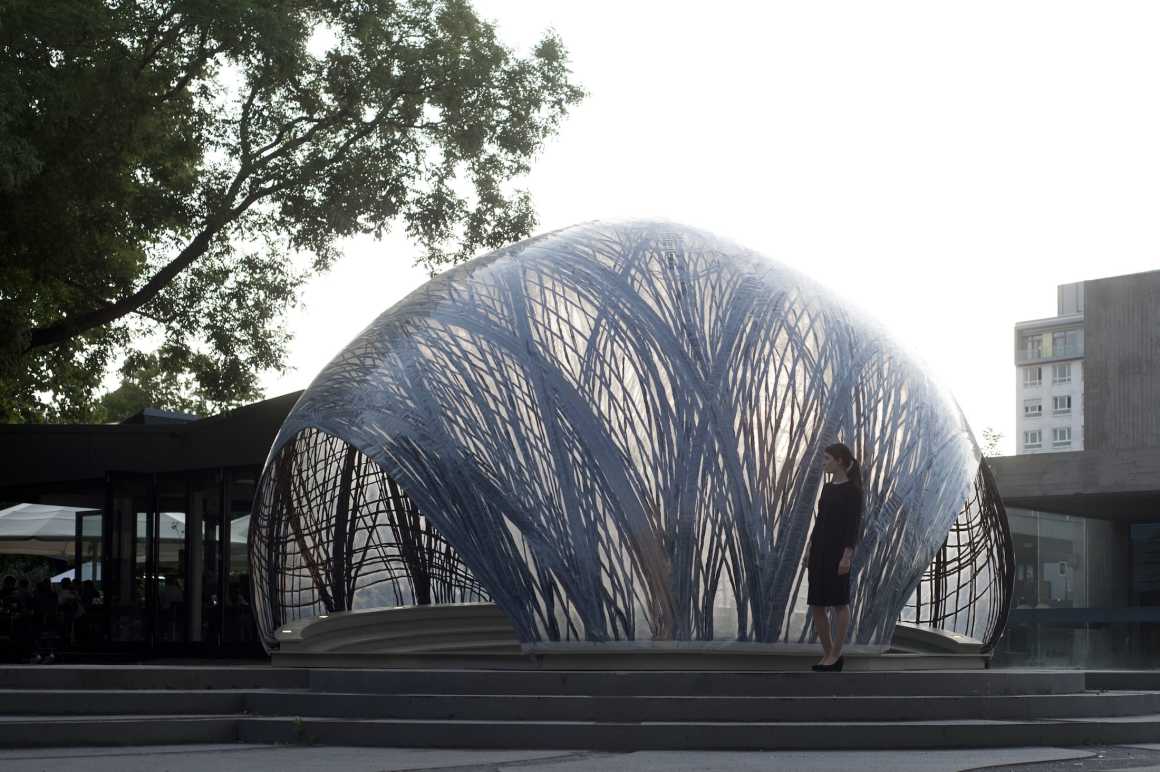
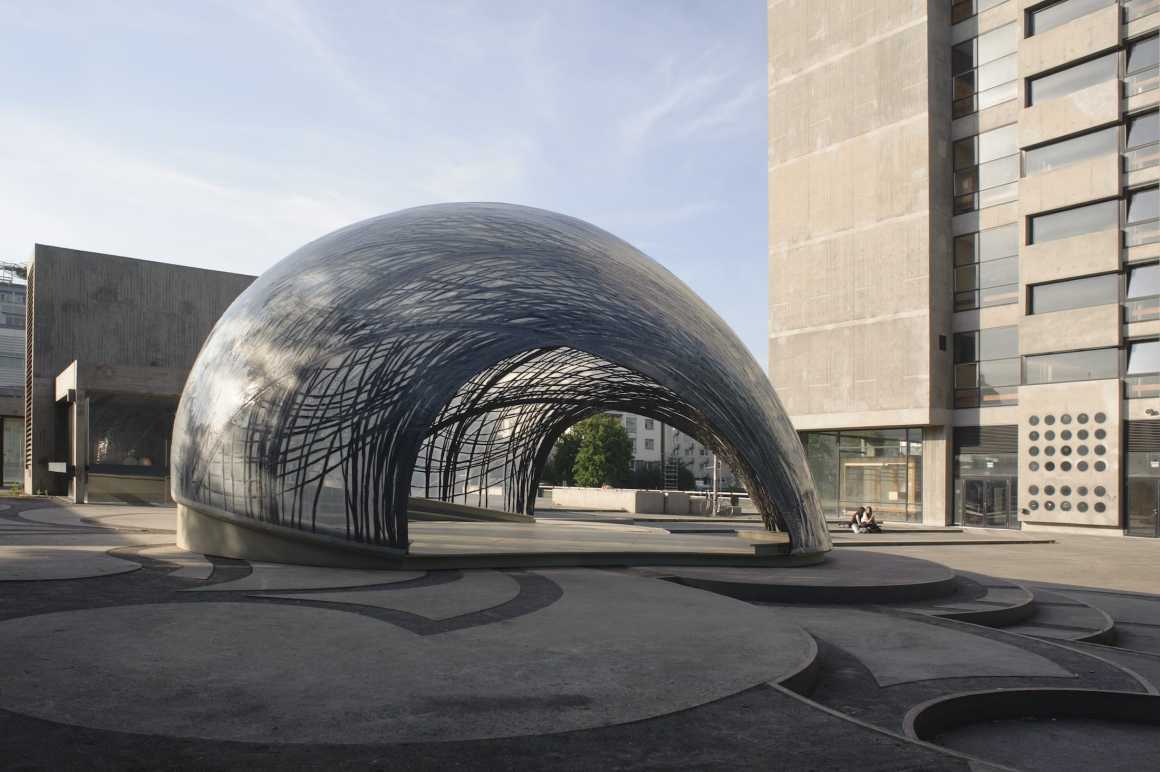
根据自适应计算设计策略,开发了一种用于柔性膜内部碳纤维增强的原型机器人制造工艺。但气动模板刚度的变化以及纤维放置过程中产生的变形波动对机器人的控制要求会比较高,为了在生产过程中精确表达这些参数,我们通过嵌入式传感器系统记录当前的位置和接触力,并实时集成到机器人控制中,这种网络物理系统的开发使得实际生产条件和机器人控制代码的数字生成之间能够不断反馈,这不仅代表了该项目的一个重要发展,而且更广泛地为自适应机器人施工过程提供了新的机会。
Corresponding to the adaptive computational design strategy, a prototypical robotic fabrication process was developed for carbon fiber reinforcement on the inside of a flexible membrane. The changing stiffness of the pneumatic formwork and the resulting fluctuations in deformation during the fiber placement process pose a particular challenge to the robot control. In order to adapt to these parameters during the production process the current position and contact force is recorded via an embedded sensor system and integrated into the robot control in real time. The development of such a cyber-physical system allows constant feedback between the actual production conditions and the digital generation of robot control codes. This represents not only an important development in the context of this project, but more generally provides new opportunities for adaptive robotic construction processes.
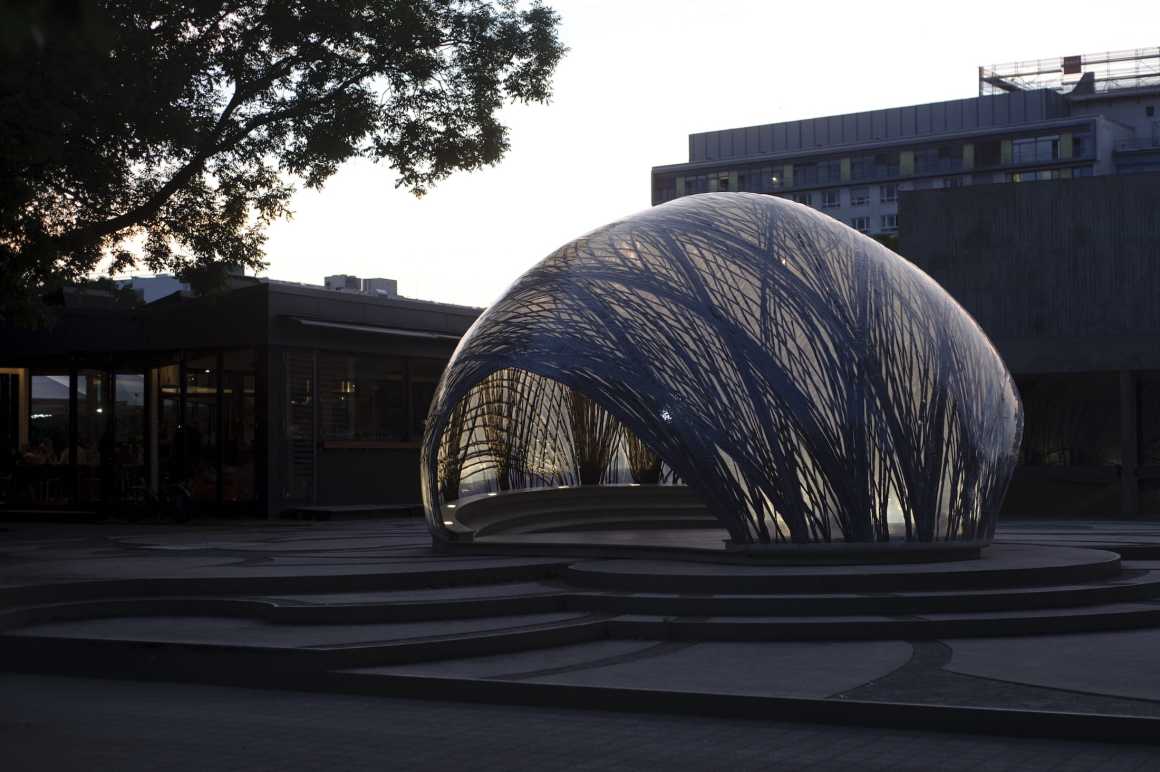
制造过程的原型特征要求开发一个定制的机器人工具,允许基于集成传感器数据放置碳纤维。该工具的技术开发成为建筑设计过程中不可或缺的一部分,这一过程也对材料体系提出了特殊的挑战,由于ETFE是一种耐用的外立面材料,其力学性能使纤维放置过程中的塑性变形最小化,因此ETFE被认为是一种可适用于气动模板和一体化建筑围护结构的材料。通过使用ETFE薄膜作为气动模板和建筑围护结构,实现了高度的功能集成,这节省了传统模板技术的材料消耗,以及额外的立面安装过程。复合粘合剂在ETFE薄膜和碳纤维之间提供了适当的粘结,在生产过程中,平行放置九根预浸渍碳纤维片,在5公里的机器人路径上以0.6米分钟的平均速度铺设45公里的碳粗纱,这种添加工艺不仅允许纤维复合材料的应力定向放置,而且还能将与典型减法施工工艺相关的建筑垃圾降至最低。2014-15ICD / ITKE研究馆建筑面积约40平方米,内部容积约130立方米,跨度7.5米,高4.1米,总建筑重量仅260公斤,相当于6.5公斤/平方米。
The prototypical character of the fabrication process required the development of a custom made robot tool that allows placement of carbon fibers based on integrated sensor data. The technical development of this tool became an integral part of the architectural design process. This process also posed special challenges for the material system. ETFE was identified as a suitable material for the pneumatic formwork and integrated building envelope, since it is a durable facade material and its mechanical properties minimize plastic deformation during the fiber placement. A high degree of functional integration is achieved through the use of the ETFE film as pneumatic formwork and building envelope. This saves the material consumption of conventional formwork techniques as well as an additional façade installation. A composite adhesive provided a proper bond between the ETFE film and the carbon fibers. During production nine pre-impregnated carbon fiber rovings are placed in parallel. 45km of carbon roving were laid at an average speed of 0.6 m min on 5km of robot path. This additive process not only allows stress-oriented placement of the fiber composite material, but it also minimizes the construction waste associated with typically subtractive construction processes. The ICD / ITKE Research Pavilion 2014-15 covers an area of about 40m2 and an internal volume of approximately 130m3 with a span of 7.5m and a height of 4.1m. The total construction weight is just 260kg, which corresponds to a weight of 6.5kg / m2.
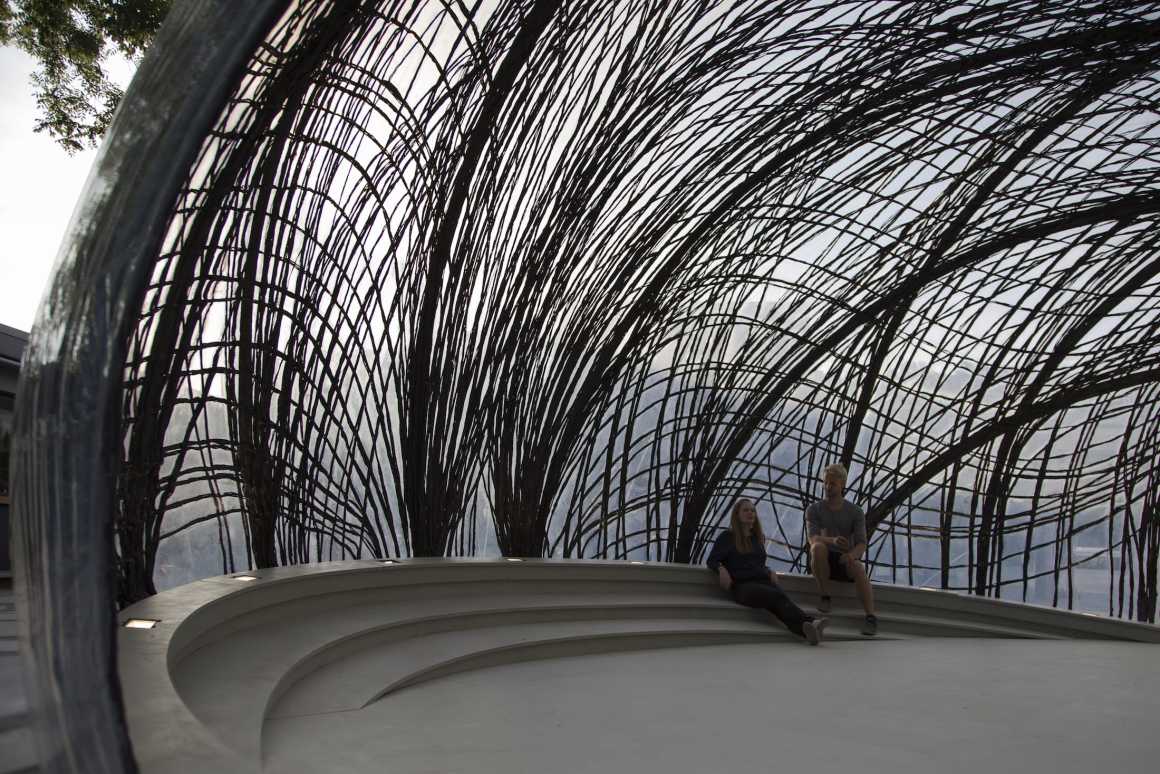
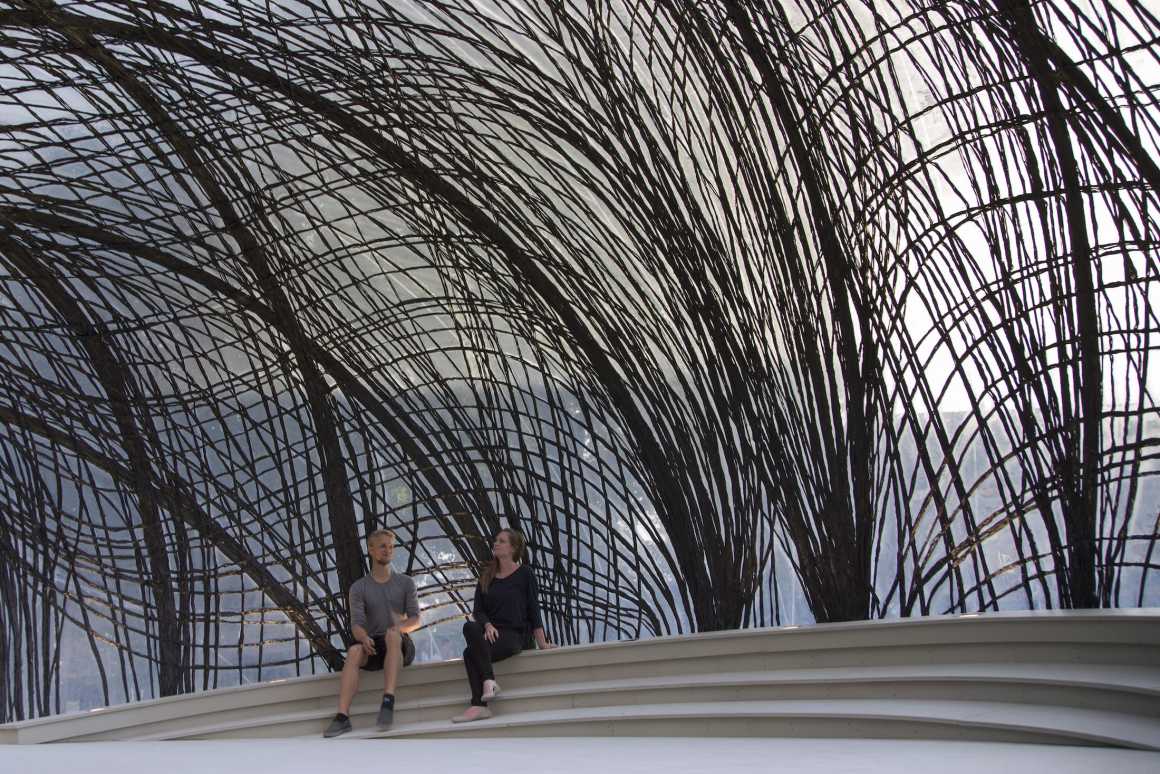
2014-2015年ICD / ITKE研究馆作为先进计算设计、仿真和制造技术的演示者,展示了跨学科研究和教学的创新潜力。该原型建筑将纤维复合材料的各向异性特征作为一种建筑品质表达出来,并以一种新颖的纹理和结构反映了底层过程,它不仅是一个特别有效的建筑材料,而且是一个创新和富有表现力的建筑演示者。
The ICD / ITKE Research Pavilion 2014-15 serves as a demonstrator for advanced computational design, simulation and manufacturing techniques and shows the innovative potential of interdisciplinary research and teaching. The prototypical building articulates the anisotropic character of the fiber composite material as an architectural quality and reflects the underlying processes in a novel texture and structure. The result is not only a particularly material-effective construction, but also an innovative and expressive architectural demonstrator.

地址:德国斯图加特Keplerstr. 11-17, 70174
完成时间:2015年6月
面积:40平方米
体积:130立方米
跨度:7.5米
高度:4.1米
建筑重量:260公斤
Adress: Keplerstr. 11-17, 70174 Stuttgart, Germany
Completion: June 2015
Area: 40 m2
Volume: 130 m3
Span: 7.5 m
Height: 4.1 m
Construction weight: 260 kg
项目团队 PROJECT-TEAM
Institute for Computational Design – Prof. Achim Menges
Institute of Building Structures and Structural Design – Prof. Jan Knippers
科技开发 SCIENTIFIC DEVELOPMENT
Moritz Dörstelmann, Valentin Koslowski, Marshall Prado, Gundula Schieber, Lauren Vasey
系统开发、制造及施工 SYSTEM DEVELOPMENT, FABRICATION & CONSTRUCTION
WS13/14, SoSe14, WS14/15: Hassan Abbasi, Yassmin Al-Khasawneh, Yuliya Baranovskaya, Marta Besalu, Giulio Brugnaro, Elena Chiridnik, Tobias Grun, Mark Hageman, Matthias Helmreich, Julian Höll, Jessica Jorge, Yohei Kanzaki, Shim Karmin, Georgi Kazlachev, Vangel Kukov, David Leon, Kantaro Makanae, Amanda Moore, Paul Poinet, Emily Scoones, Djordje Stanojevic, Andrei Stoiculescu, Kenryo Takahashi and Maria Yablonina
WS14/15: Rebecca Jaroszewski, Yavar Khonsari, Ondrej Kyjanek, Alberto Lago, Kuan-Ting Lai, Luigi Olivieri, Guiseppe Pultrone, Annie Scherer, Raquel Silva, Shota Tsikoliya
With the support of: Ehsan Baharlou, Benjamin Felbrich, Manfred Richard Hammer, Axel Körner, Anja Mader, Michael Preisack, Seiichi Suzuki, Michael Tondera
合作伙伴 IN COLLABORATION WITH:
Departement of Evolutionary Biology of Invertebrates, University of Tuebingen Prof. Dr.Oliver Betz
Departement of Palaeontology of Invertebrates, University of Tuebingen Prof. Dr.James Nebelsick, Dr.Christoph Allgaier
Institute for Machine Tools, University of Stuttgart
Dr. Thomas Stehle, Rolf Bauer, Michael Reichersdörfer
Institute of Aircraft Design, University of Stuttgart Stefan Carosella, Prof. Dr.-Ing. Peter Middendorf
更多 Read more about: ICD





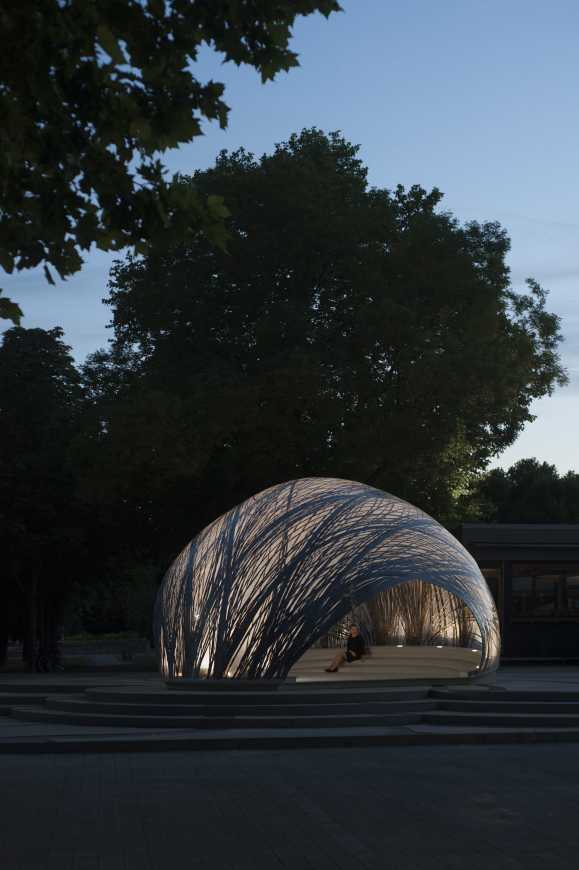
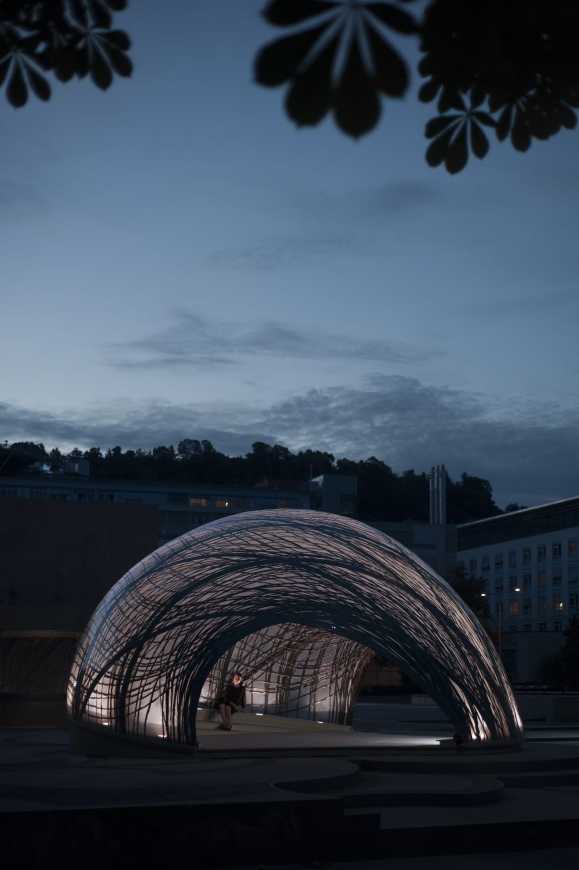
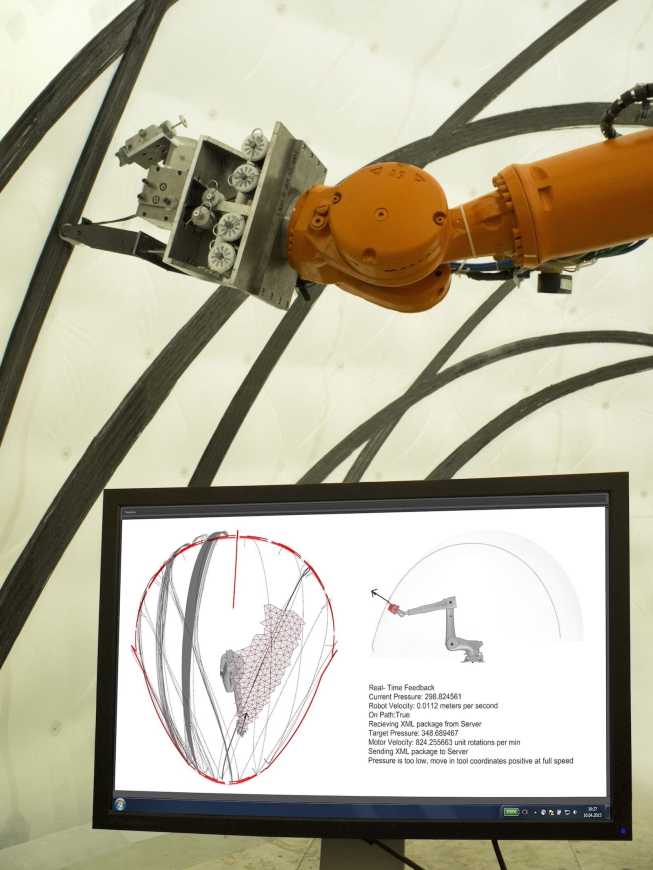

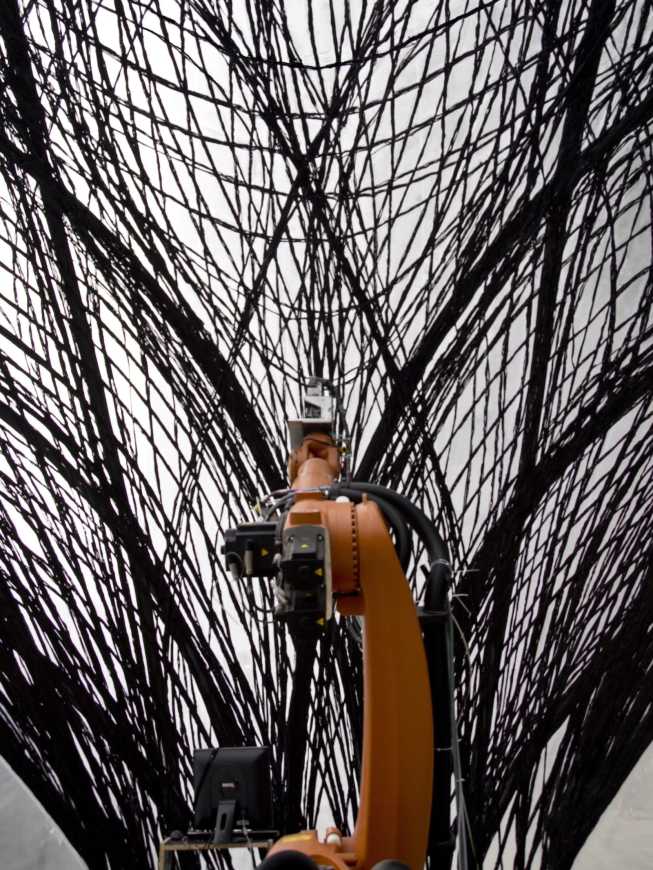
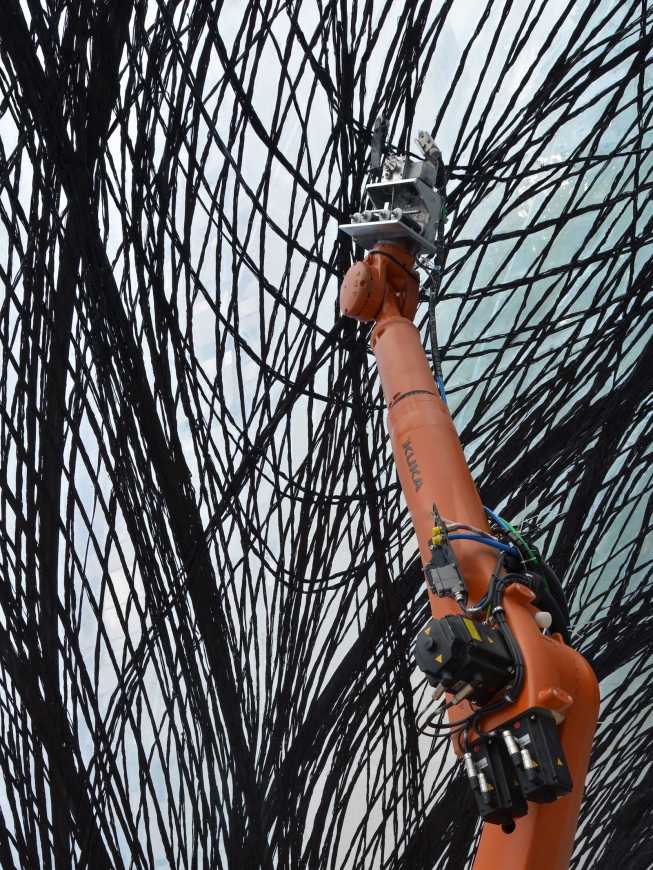
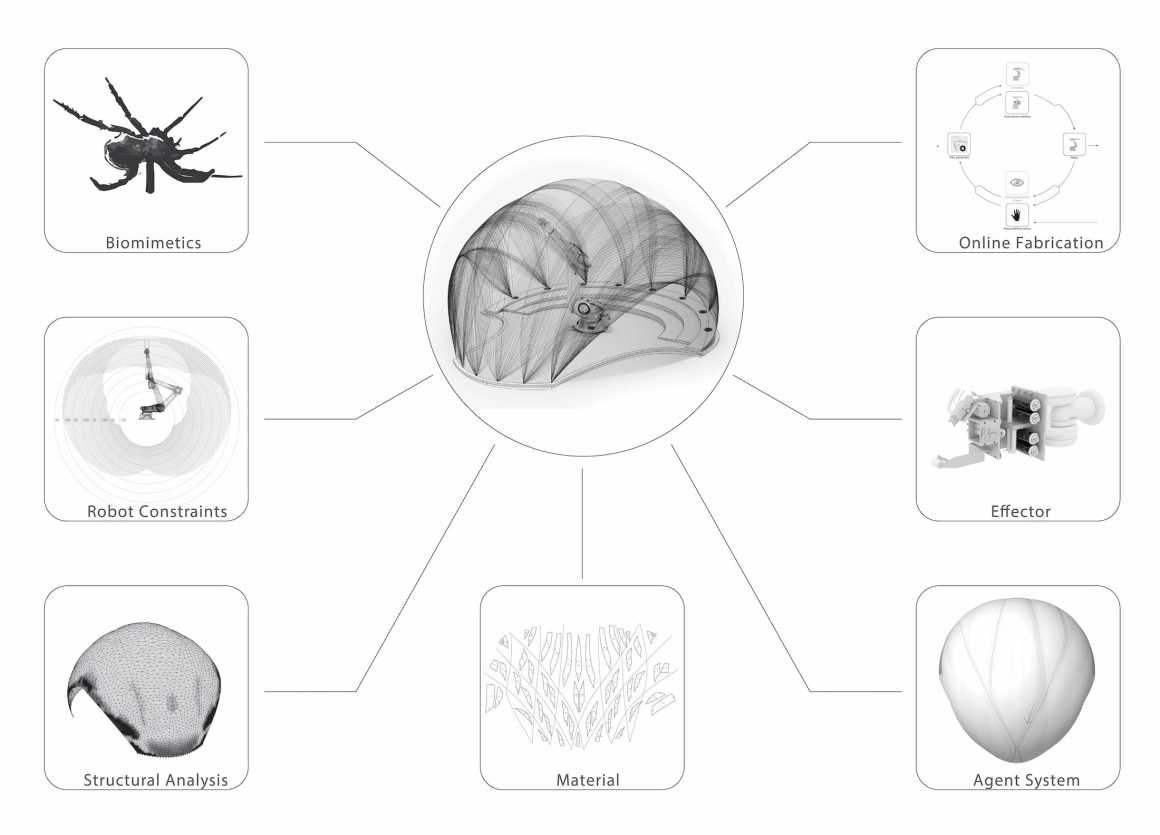


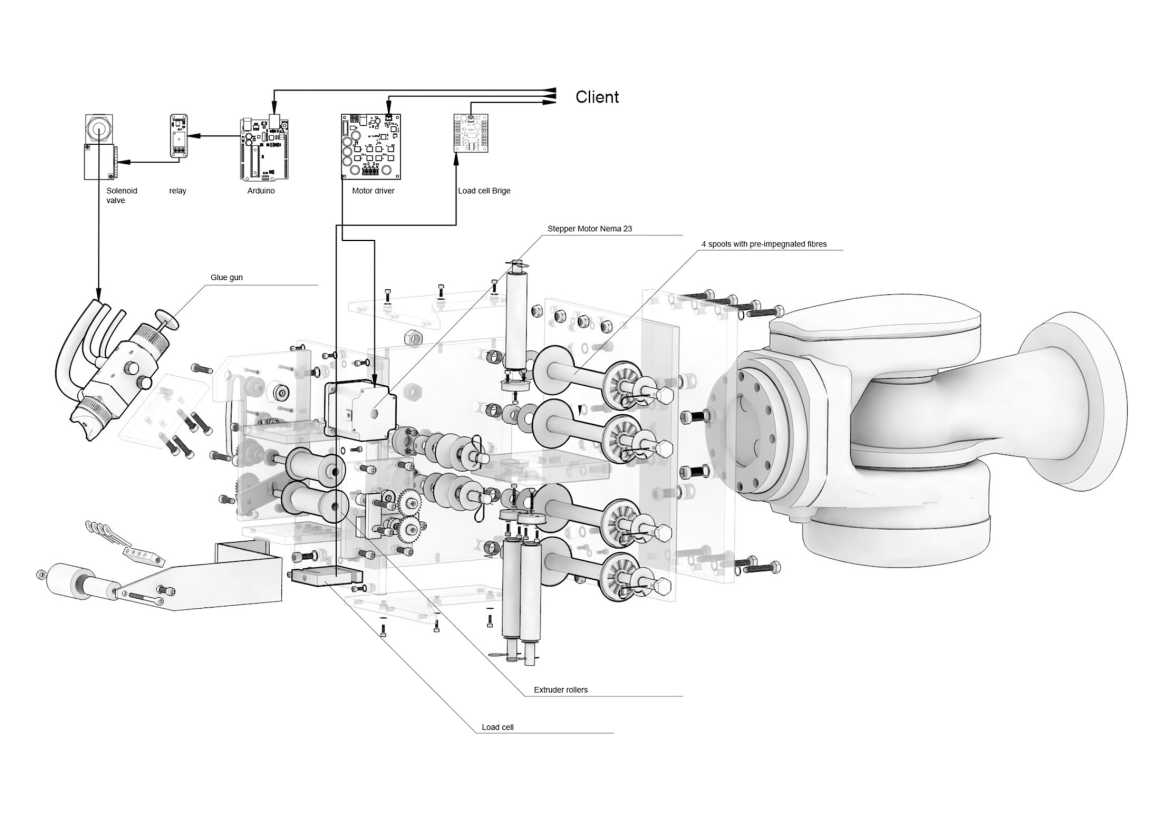

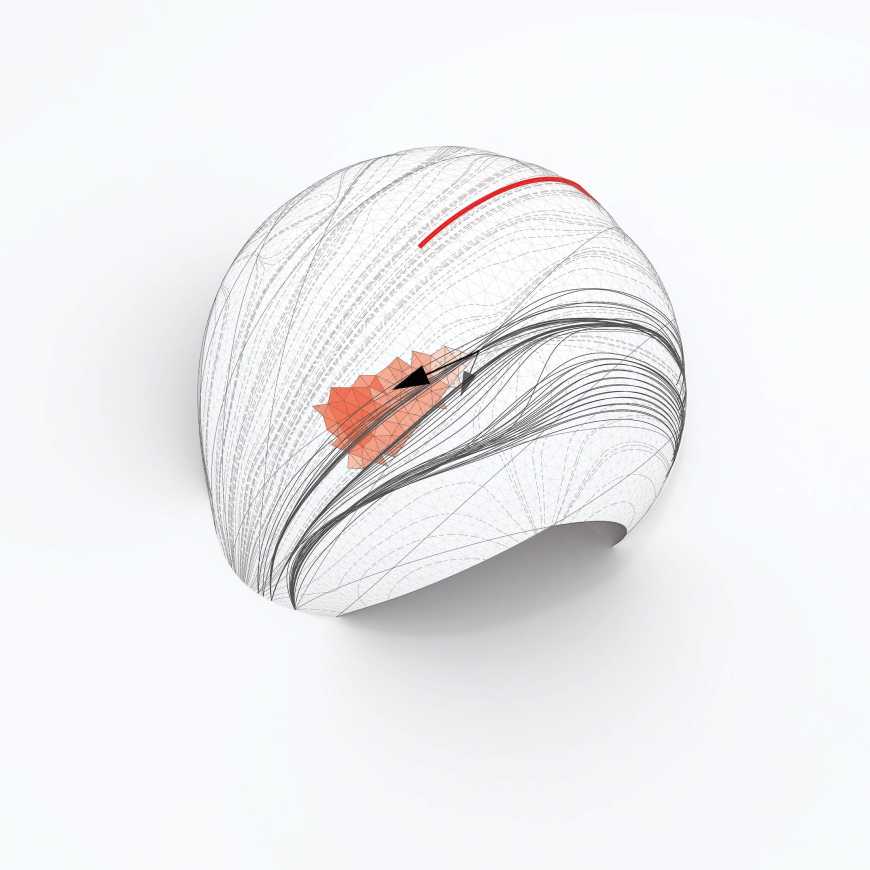

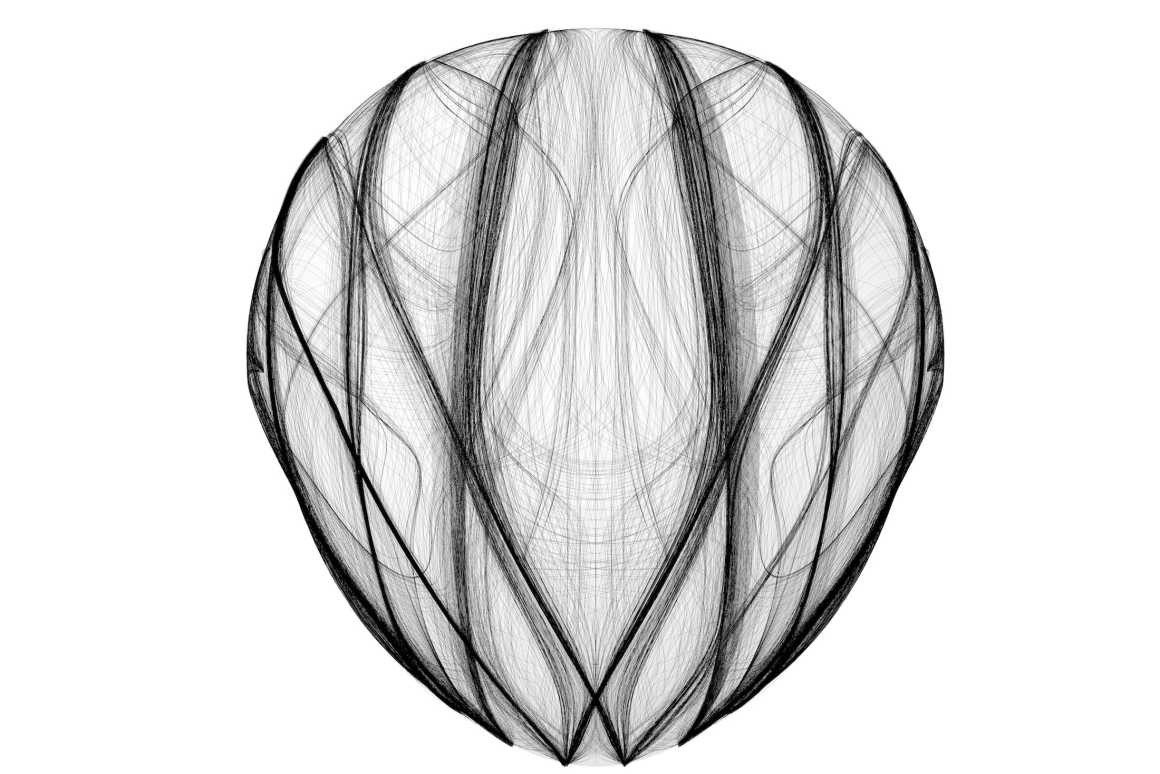
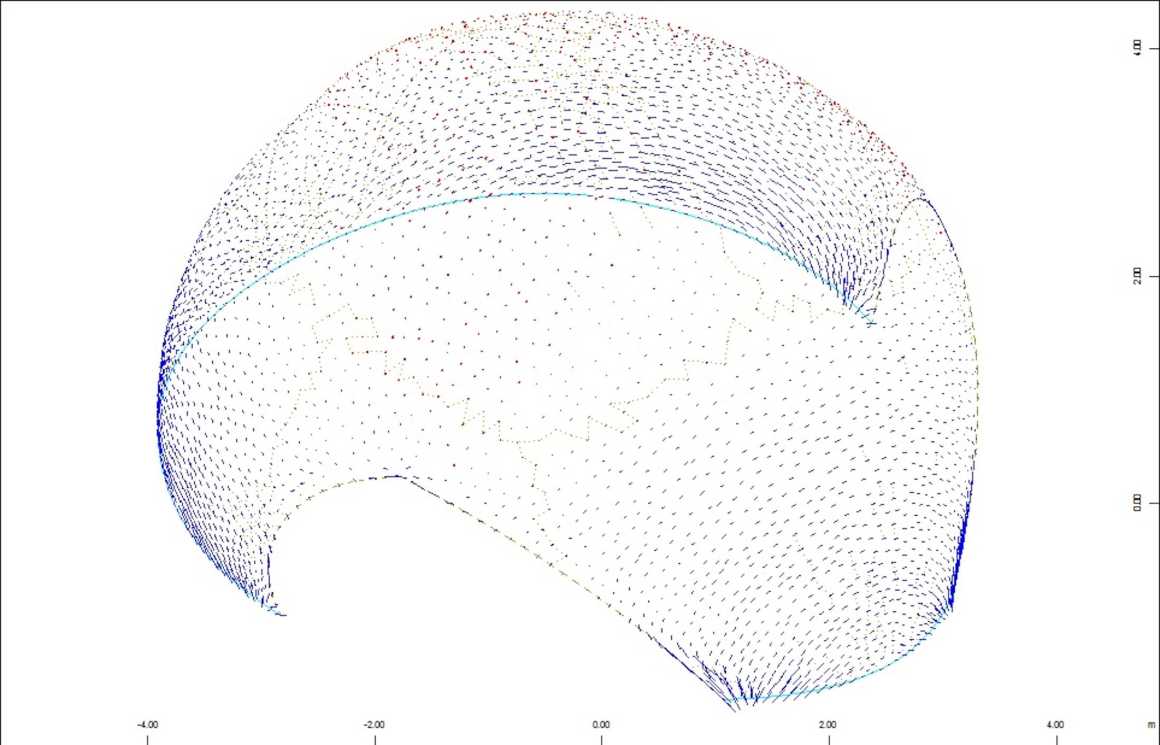

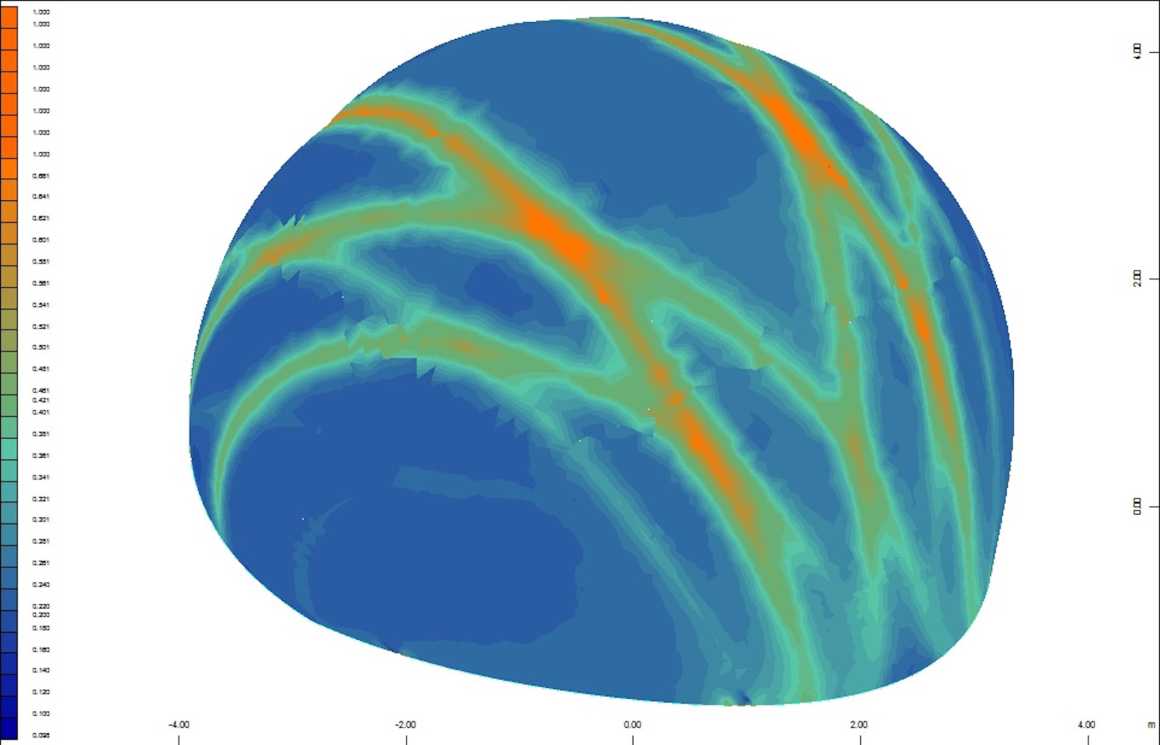



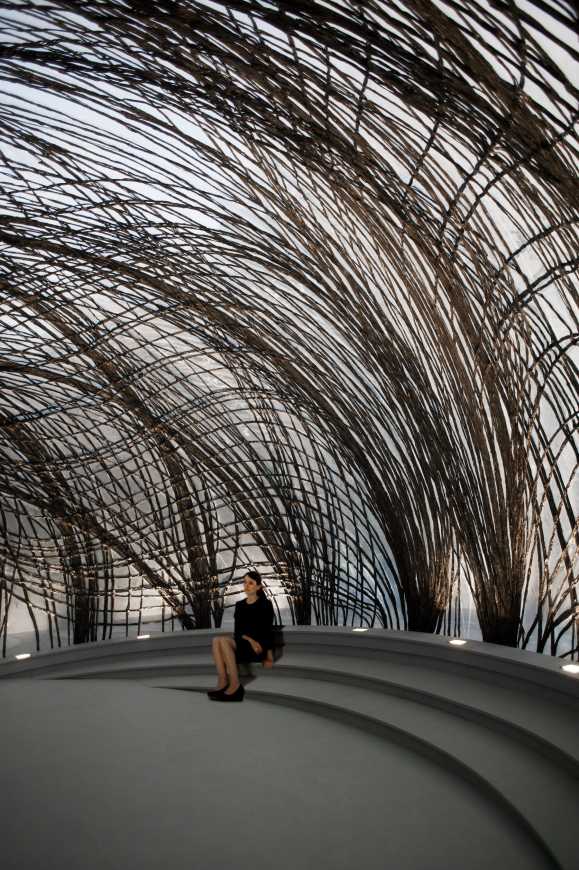


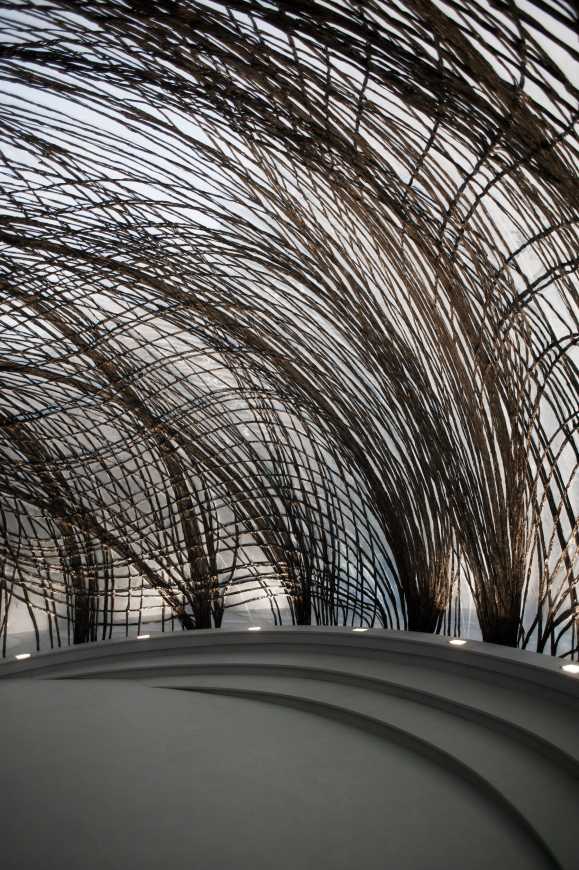


0 Comments